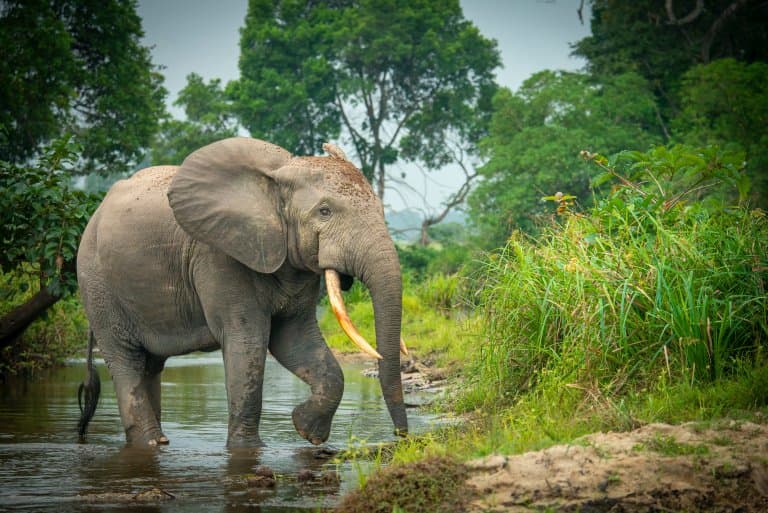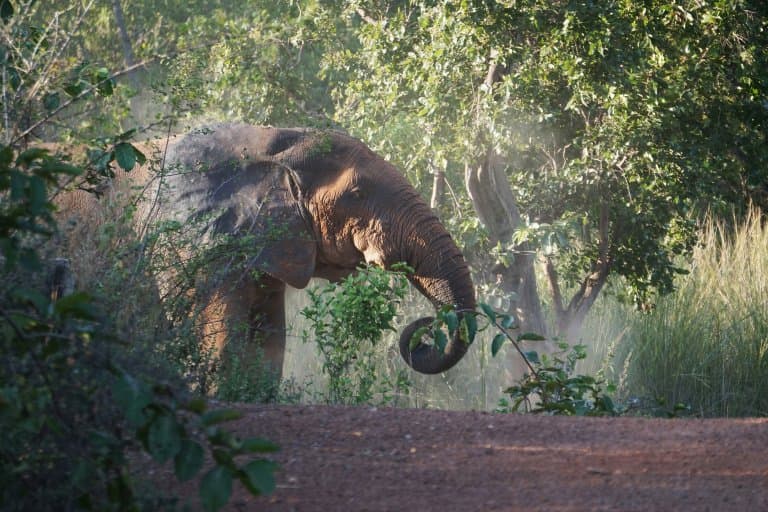African Forest Elephant Profile
Once thought to be a subspecies of the African bush elephant, the African forest elephant is now recognised as a separate species.
Unlike the more commonly known African bush elephant (also known as the African savanna elephant), the forest elephants in Africa rarely venture far from dense forest and are far shyer than their larger cousins.
Forest elephants are much smaller than bush elephants with a height of up to 2.4m compared to the 3-4m metre height of the bush elephant. Forest elephants have smaller, more rounded ears and straighter, downward-facing tusks that allow them to move through the dense forest more easily.
African forest elephants are only found in a few countries across central and western Africa. They are confined to dense, tropical rainforests which are slowly being reduced in size due to deforestation and climate change.

African Forest Elephant Facts Overview
| Habitat: | Dense tropical rainforests |
| Location: | Central and Western Africa |
| Lifespan: | Around 60 years in the wild |
| Size: | Up to 2.4m in height at the shoulder, length around 2m |
| Weight: | 2,000 – 7,000 kg (4,400 – 15,400 lb) |
| Color: | Similar to the bush elephant but their hide is slightly darker. Smaller than the bush elephant with more rounded ears and thinner, straighter tusks |
| Diet: | Herbivorous feeding on many types of fruit, as well as leaves, seeds and grasses |
| Predators: | No natural predators. Humans are their main threat |
| Top Speed: | 36km/h |
| No. of Species: |
1 |
| Conservation Status: |
Critically Endangered |
African forest elephants very shy animals and are rarely seen due to their preference for thick, dark forest. They travel in smaller herds than bush elephants and hardly ever interact with other herds, rather sticking to their well-memorised routes through the dense undergrowth in search of food.
The diet and behaviour of the African forest elephant is similar to other forest-dwelling animals and despite being less closely related, they share many similarities with the Asian elephant. Whereas bush elephants feed primarily on grasses and other foliage, fruits make up a large proportion of the diet of a forest elephant. They eat up to 72 different types of fruit, as well as leaves and bark.
Family groups will travel up to 5 miles each day through the undergrowth to visit fruiting and seeding trees, using their excellent sense of smell and superb memory to locate these feeding grounds. Like other elephants, they regularly visit salt-licks to increase their mineral intake. In order to do this, forest elephants will travel to a known spot and then dig up and eat the mineral rich soil.
Like all elephants, African forest elephants love water and forest elephants in particular are not often found far from a water source. There, they use their long trunks to suck it up, filter out any sand and dirt and then swallow the fresh water.
They are also fond of mud-baths which help protect them from the sun as well as biting forest insects. Most of their trails to water and food sources are permanent and these routes are passed down generation after generation.
Herds are usually made up of a female matriarch, her siblings and their offspring. Males leave these herds when sexually mature and live a solitary existence. African forest elephants live in small herds of around 5 individuals who are often all female relatives. When females are ready to mate they generally leave the group when they encounter a male. 1
Sadly, their population has decreased by more than 80% over the past 3 generations due to habitat loss, habitat fragmentation amd poaching for ivory and bushmeat. Subsequently, the African forest elephant was declared critically endangered by the IUCN in 2021.
Interesting African Forest Elephant Facts
1. African forest elephants are a separate species from the bush elephant
They were long considered a subspecies of the African bush elephant, but morphological and DNA analysis showed that they are two distinct species.
African forest elephants are smaller, have more rounded ears and straighter, downward facing tusks. 2

2. African forest elephants are the smallest elephant species
From the three living elephant species, the African bush elephant, the African forest elephant and the Asian elephant, the African forest elephant is the ‘smallest’.
The African bush elephant is the largest growing up to 4m in height and weighing 10 tons.
The Asian elephant averages around 2.75m at the shoulder and 4 tons in weight, while the African forest elephant is the smallest at 2.4m and 2-4 tons.
African forest elephants can hardly be described as ‘small’ though, it is relative – they are still the third largest living land animal on the planet.
3. Their tusks can grow up to 1.5m (4ft 11) in length
And weigh up to 45kg! They are used to push through the dense undergrowth of their habitat.
The African forest elephant has pink tusks that are smaller and tougher than the African bush elephant’s tusks.
4. Most forest elephants are found in just 2 countries
Gabon and the Democratic Republic of Congo are home to the largest populations of African forest elephants. In particular, suitable habitat covers 90% of Gabon.
Smaller populations can also be found in areas of the Ivory Coast and Ghana.
5. They are very shy animals
Due to their reclusive nature and the dense forests they inhabit, forest elephants are rarely seen.
Although forest elephants have historically been active during the day, they now tend to live a more nocturnal existence, utilising the dark night to provide protection from poachers and hunters. 3
6. Their population numbers are estimated from their dung
As forest elephants are very difficult to find, scientists count dung piles to determine the number of individuals in an area.
7. Forest elephants eat huge amounts in a day
They can eat over 200kg of plant matter in a day. Forest elephants include a large amount of fruit in their diet. 4

8. Females are pregnant for up to 2 years
Elephants have the longest gestation period of any animal.
The largest males tend to mate with the most females and after mating they leave to find other females. Females can be pregnant for up to 2 years before giving birth to a single calf, which is able to walk within minutes of being born.
Mothers nurse their young for up to 6 years and other females in the group will also help care for the calf. While male calves leave the group when they are around 12 years old, females remain with the herd.
9. African forest elephant population growth is slow
As females are pregnant for 2 years and will not have another calf for over 5 years, their population will take decades to increase.
10. There are 40,000 – 60,000 muscles and tendons in their trunk
The trunk is actually just a long nose! At the tip of the trunk of an African elephant, there are two finger-like features which can be used to perform quite delicate tasks such as retrieving and manipulating tiny items. This differs to the Asian elephant which has only one of these ‘fingers’.
As with the other elephant species, African forest elephants use their long trunks for a multitude of tasks. In addition to using their trunk as a water filter, they also collect fruits and leaves with them. Their trunks are highly sensitive and this helps the elephants detect different objects in their vicinity through touch. 5
They can manipulate branches with their trunks to create fly swats and will even push objects into open waterholes so that the water does not evaporate before their next visit. African forest elephants have excellent vision and smell, which helps them choose ripe fruits and suitable leaves.
11. Elephants are very intelligent
Elephants are one of the smartest animals on the planet, and have shown a remarkable ability to use tools, such as using branches to swat flies or to scratch themselves.
Forest elephants are capable of memorising paths, feeding areas and water sources. Adults teach the calves how to navigate through the forest, use salt licks and how to access fruits on fruiting trees.
They have excellent memories and can retrace a path having not visited it in decades. 6

12. They can communicate over vast distances
Forest elephants can also communicate with other family members who may be over 2km away. Their calls are made in a low-frequency, known as infrasound, and are undetectable to human ears.
Forest elephants are also sensitive to tiny vibrations in the ground and can detect approaching animals or people several kilometres away.
Hearing and smell are the most crucial senses for these creatures because they have poor vision.
13. Some forest elephants are actually hybrids
Even though they are separate species, forest elephants can mate with savanna elephants and produce fertile offspring.
14. Their dung is an excellent fertiliser
African forest elephants are known as architects of their habitat due to the effects their activities have on the ecosystem. They open up underground water sources, providing water for other forest animals. Forest elephants also create large openings in the forest, especially where there is water or salt licks present.
These clearings increase tree biodiversity as well as creating a different ecosystem which again supports many other animal and plant species. Forest elephants are key seed disbursers, transporting fruit and other tree seeds great distances.
Their dung provides an ideal environment for seed germination and this again increases tree number and diversity in the forest.
15. Elephant dung has surprising uses!
Elephant dung can be used to make paper and mosquito repellent. Coffee beans found in elephant dung are sold for hundreds of dollars per kilogram.
16. They are still under significant threat
Due to poaching and deforestation, the African forest elephant population has reduced by over 90% in the last 100 years.
In 2013, the population size was estimated to be around 30,000 elephants in total.
More positively, the Wildlife Conservation Society and the National Parks of Gabon conducted the first survey in 30 years in 2021, and found an estimated 95,000 forest elephants in Gabon. Previously, the population was thought to be between 50,000 and 60,000.
While poaching and commercial trade of African elephants is illegal, it’s still a problem. However, there are many conservation efforts ongoing in National Parks to try and protect elephants. 7

African Forest Elephant Fact-File Summary
Scientific Classification
| Kingdom: | Animalia |
| Phylum: | Chordata |
| Class: | Mammalia |
| Order: | Proboscidea |
| Family: | Elephantidae |
| Genus: | Loxodonta |
| Species Name: |
Loxodonta Cyclotis |
Fact Sources & References
- Tara Connor, “Loxodonta cyclotis African forest elephant”, Animal Diversity Web.
- Kathleen Gobush (2021), “Loxodonta cyclotis, African Forest Elephant”, ResearchGate.
- Jeheskel (Hezy) Shoshani (1999), “elephant”, Britannica.
- “African Forest Elephant”, Word Wild Life.
- Julie Bonnald (2022), “Phenotypical characterization of African savannah and forest elephants, with special emphasis on hybrids: the case of Kibale National Park, Uganda”, Cambridge.
- Ferris Jabr (2014), “The Science Is In: Elephants Are Even Smarter Than We Realized“, Scientific American.
- “African elephant species now Endangered and Critically Endangered”, IUCN.
